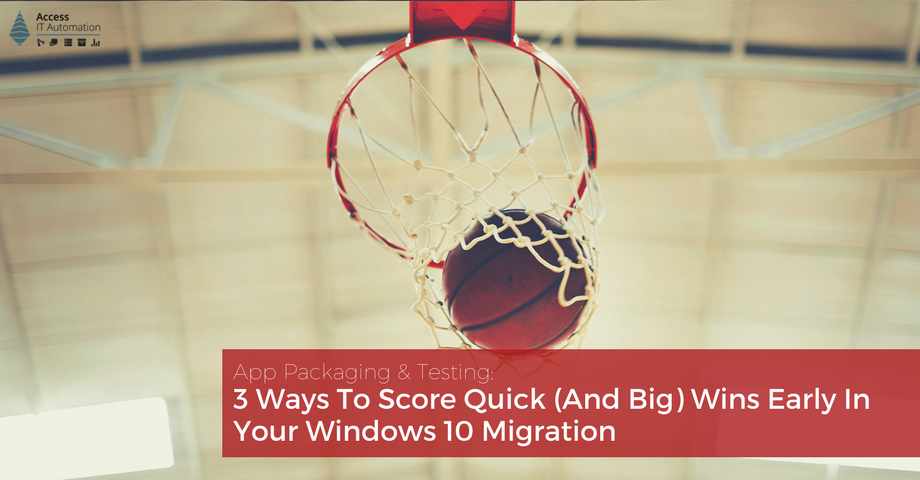If you are planning on finally tackling that enterprise-wide Windows 10 migration in 2018, you might want to stop what you are doing and read this article first!
We have seen many enterprises head into this migration without adequate planning for application packaging and testing — wasting precious opportunities for immediate quick wins. In addition, with Windows-as-a-Service, you are facing another hurdle: you will have to update at least once, better yet twice, a year — so your update process has to run like a well-oiled machine.

One of the most effective ways to achieve this goal is to define your application management strategy before you even start building your Windows 10 migration or upgrade strategy. This will enable you to:
- Gather All Data Required To Validate Your Windows 10 Migration/Update Project Scope
- Eliminate 35-50% of your applications by rationalization, normalization, identification
- Run your applications through an automated re-certification process to determine upgrade suitability
[For more IT automation ideas, check out our resource guide “12 Ways The Fast And Bold Use IT Automation To Achieve Evergreen”.]
1) Gather All Data Required To Validate Your Windows 10 Migration/Update Project Scope
More often than not, an enterprise Windows 10 migration project, or any IT Transformation project in general, is doomed from the start if an organization doesn’t determine the scope of the project properly until it is knee-deep into the project.
This isn’t necessarily done by neglect or on purpose as many IT project managers simply don’t have the data available to them, and underestimating the scope can have catastrophic implications on your project!
To avoid this fate, you want to start any larger IT Transformation project by defining the exact scope of the project before you even start. Without this information, you won’t be able to formulate your migration strategy properly. This includes for example:
- How many users will be migrated
- How old your hardware estate is and what percentage of hardware needs to be replaced (you might find out that you have to piggyback a hardware refresh onto your migration project)
- How many applications will need to be touched during this project, how many are suitable for an upgrade out-of-the-box,
- How many need to be re-packaged and re-tested, and
- How many can be retired
and so on.
Do your due diligence here and remember the famous saying from Peter Drucker: “You can’t manage what you can’t measure!”
2) Eliminate 35-50% of Applications By Rationalizing, Normalizing, & Identifying
Once you know what you are dealing with, it’s time to trim some fat! Since every larger IT Transformation is heavily influenced by the amount of applications that have to be certified, packaged, and tested, eliminating unused or duplicate applications from your project scope can cut down 35-50% of your in-scope applications — which in turn has a significant impact on your project timeline and costs.
The way to accomplish this is by rationalization, normalization, and identification. The goal is to find out what apps are being used and which are critical. For example, I recently worked with a large organization that had close to 100,000 applications within scope. However, every single application had a very slightly different version which counts as another count across all the different workstations. Even renamed sites in the SCCM could result in another count for the exact same site but with a slightly different naming.
Normalizing and rationalizing all of your applications might seem a little overwhelming at first, but you will be surprised at how much you can cut out, and you eliminate the tedious manual exercise of weeding out all of the unnecessary versions and multiple versions of applications later on. This way you can trace all these EXE files launched to the appropriate MSI file, which matches back to an SCCM, which matches back to an AD group with users associated with it.
Plus, you gain a clear understanding of what you have in house which could lead to retirement of unused or older duplicate versions, saving you on licensing and maintenance costs.
While Access Capture doesn’t have that information, you can upload it into the platform’s database or join it up with tools like Juriba’s Dashworks using restful APIs. This information serves then as automation triggers for those bits of automation around packaging or testing of a particular version of an app or testing.
At this point, you also determine all the irrelevant apps that should not be included in your migration efforts, such as language packs, hot fixes and patches, etc. Now, you have an exact list of applications you need to include in your project.
3) Run Your Applications Through An Automated Re-Certification Process To Determine Suitability
The biggest hurdle you will then have to overcome is testing for application suitabilityand, if needed, packaging and re-certifying your apps. Since the average enterprise will touch around 1,500 applications during an OS migration, you should focus on getting your application management strategy nailed down first.
While some information can be compiled from HR feeds (number of employees, contractors, and temp workers), desktop management solutions like SCCM (e.g., basic application usage data through Software Metering and Software Inventory), and other readily available sources, organizations often lack this consolidated view of users, devices, and applications that organizations need to validate scope of activity.
Luckily, you can use Access Capture to quickly run your entire estate through a re-certification to find out how many applications are compatible with the latest version of Windows 10 — and for those that are not, you can determine if an upgrade path is available and how much re-packaging and re-testing effort will be required.
Want to learn more about how IT automation can help streamline your Windows 10 migration and other IT Transformation initiatives? Schedule a consultation below or download our quick cheat sheet “Windows 10 Packaging & Testing Gotchas” for more expert advice.